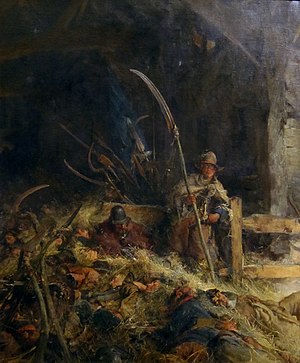Ford Wars
The Ford Wars were a series of social and religious upheavals in modern southern Faneria from a period roughly spanning the Tenth, Eleventh, and early Twelfth Centuries AD. During this period, the traditional Gaelic clan-based social order in the region collapsed, conversion to Christianity expanded enormously, and many of the polities in the region collapsed or underwent significant periods of decline or reform.
Origins
The Ford Wars were historically attributed to the decline in power of the Republic of Daingean in the central Vandarch and the rise of the Principality of Itheachan in the East. While broadly correct, later historiography also attributes the chaos of the period to the exponential expansion of Christianity into major population centers and a concurrent decline in trade along most of the Vandarch trade routes.
Urbanization and Christianity



Christianity had been practiced in the Kestrel Isles and parts of the eastern Vandarch coast since at least the 7th Century AD, with the most important step being the establishment of the first permanent church on the mainland by Saint Hendrick in the Eighth Century AD. An influx in Christian missionaries during the early 9th Century followed the successful Christianization of Western Dericania, many of whom enabled the expansion of abbey-centered cottage industries in the East. These missionaries received mixed reactions, particularly surrounding their frequent proselytizing to Gothic slaves in Itheachan and attempting to intervene in the many low-intensity conflicts ongoing during the period. Both avenues proved useful, but Fhainnin Christian practitioners were often preferred targets for murder, abduction, and robbery due to most early converts coming from the walled city-states that predominated local politics, rather than the numerous clan-centered villages.
The growing divide between religious communities already separated by cultural differences eventually bred a sense of what many writers summarize as 'an impetus to civilize' the rural clans by the city peoples. In most cases, there was a noticeable difference, as rural regions were both less homogenous and more thoroughly Gaelic and spoke their pre-Conquest Gaelic langauges, whereas the city-states typically spoke dialects of Fhes and retained significant Fenni cultural and genetic descent. This partial turnabout in the culture intermingled Christianity with the homogenizing Fhainnin identity and lead to frequent raids and massacres between these groups.
Brigandry and Banditry


Daingean and Itheachan
End of the Ford Wars and Aftereffects
- traditional naming conventions became incomprehensibly complex due to population scale+widespread fraud and contraction in used given names
- clans fell apart mostly due to